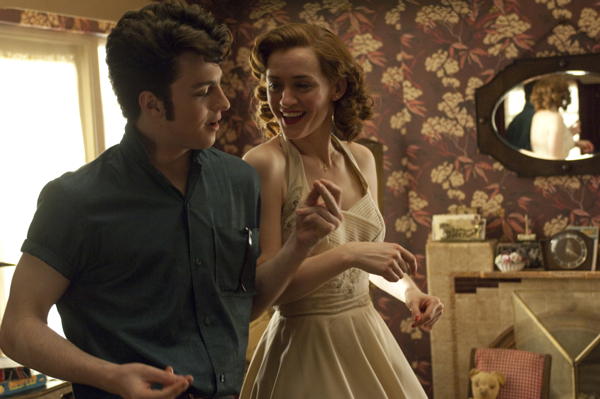Movie review by Greg Carlson
Artist Sam Taylor-Wood, whose “Crying Men” project captured tearful shots of famous movie actors, makes her feature motion picture directorial debut with “Nowhere Boy,” a mostly straightforward biographical portrait of the young John Lennon. Many hardcore Beatles disciples might weep at the movie’s wildly speculative attitude, which focuses on the intense psychological triangle formed by Lennon (Aaron Johnson), Lennon’s birth mother Julia (Ann-Marie Duff), and Lennon’s aunt Mimi (Kristin Scott Thomas).
Taylor-Wood burnishes the mythology of Lennon’s formative years with a relentless Oedipal tug-of-war that pulls young John between the stiff, sensible woman responsible for raising him and the wayward but far less stable free-spirit who chose to give him up. The sexual tension between John and Julia is liberally applied, occasionally to the point of distraction. The director, whose off-screen relationship with star Johnson has raised a few eyebrows as something like life imitating art, is more than two decades older than her lead performer, and if nothing else this bit of biographical reading juices the film’s otherwise moderate pulse.
“Nowhere Boy” is no worse than several other attempts to imagine events in the lives of the Beatles, and like “The Hours and Times” and “Backbeat,” a pair of films in which Lennon was played by Ian Hart, plenty of liberties are taken for the sake of narrative coherence and plot velocity. To the credit of Taylor-Wood, screenwriter Matt Greenhalgh, and actor Aaron Johnson, “Nowhere Boy” makes a point of showing John at his most abusive, sarcastic, and churlish. Lennon’s teenage rebelliousness emerges as one of the movie’s strong suits, and the future superstar’s capacity for cruelty will startle those expecting only peace and love.
Despite the deliberate refusal to utter the “B” word at any point in the movie, visual portents of John’s future pop up throughout, including the July 6, 1957 meeting of Lennon and McCartney following a Quarrymen show at St. Peter’s Church in Woolton, sketches of a walrus in John’s notebook margin doodles, and name-checked landmarks like Strawberry Field children’s home and the Cavern Club. More intriguing is the adroitly selected soundtrack, which features prime cuts ranging from Jackie Brenston’s thrilling “Rocket 88” to Big Mama Thornton’s indispensable “Hound Dog” to an entire sequence built around Screamin’ Jay Hawkins’s “I Put a Spell on You.”
In addition to the influential records that would guide Lennon’s musical sensibilities, “Nowhere Boy” employs the classic proposition that presents musical exploration and release as a shelter from anguish, frustration, and emotional pain. Fleeting glimpses of John maturing as a musician, songwriter, and performer pale when compared to recordings of the genuine article (the only actual Lennon on the soundtrack is the appropriately placed “Mother” over the closing credits). Johnson, in addition to McCartney portrayer Thomas Brodie Sangster and others, credibly re-records material performed during John’s youth, and early composition “Hello Little Girl” features in one scene. Like many biopics, “Nowhere Boy” concludes with a montage of historical photographs, a tactic that both reminds viewers of the skills of the production and costume designers and presents the “proof” that these incredible events really transpired.
